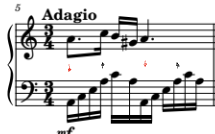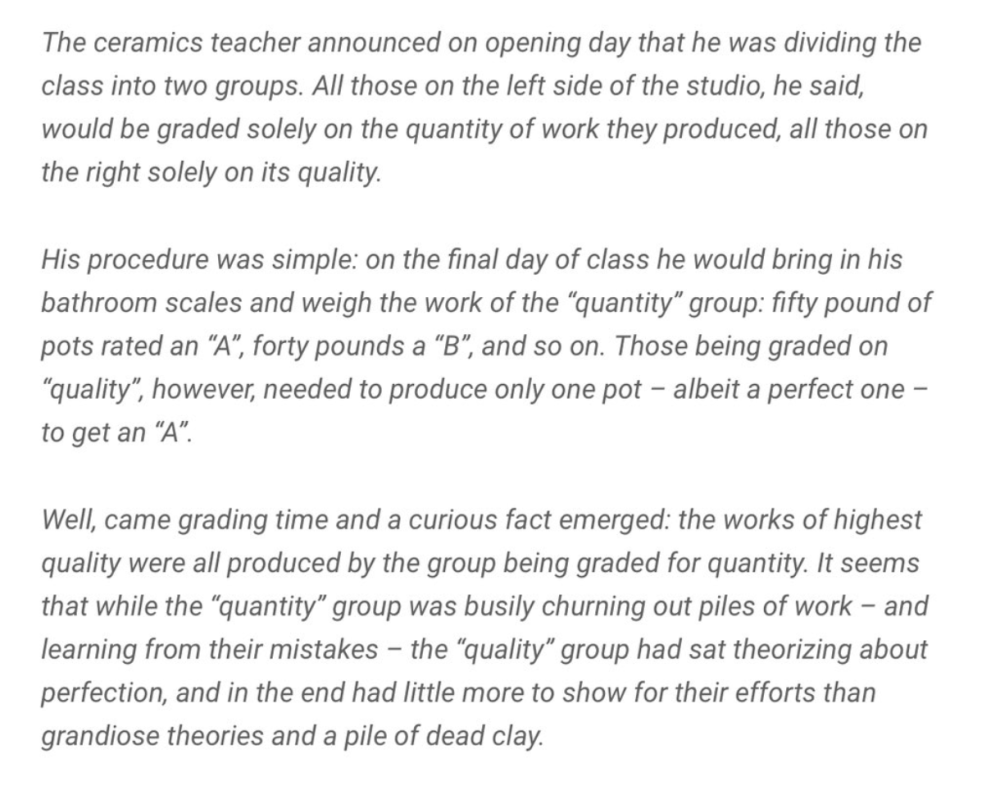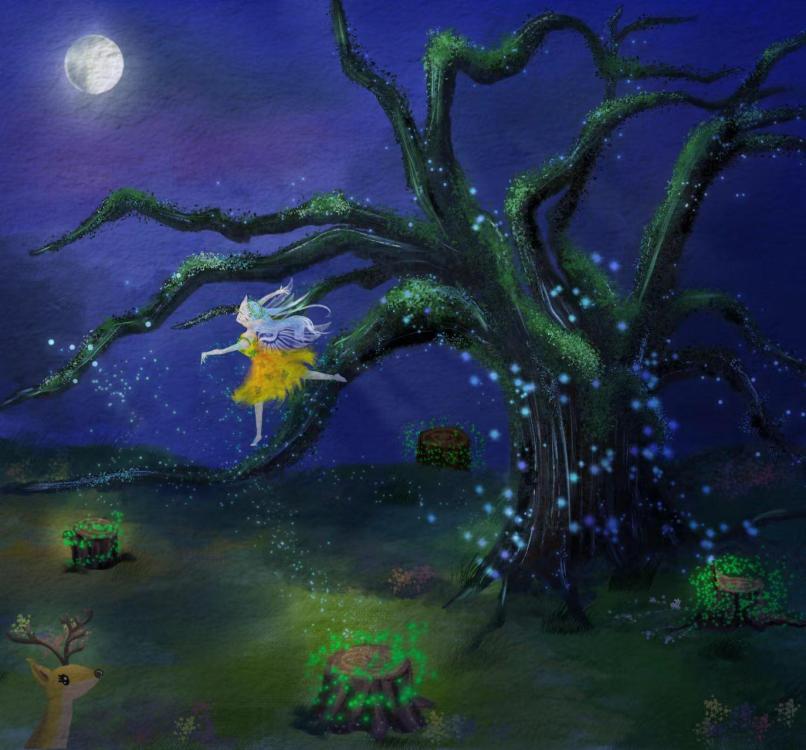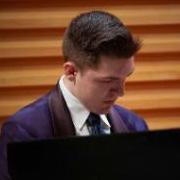Leaderboard
Popular Content
Showing content with the highest reputation since 11/09/2025 in Posts
-
4 points
-
Wow! I drop this here and look away for a moment (or several weeks), and y'all bless me with an embarrassment of riches in your comments! I'm so sorry I'm just now getting around to replying, but I've been a bit unwell. I suffer from Bipolar Disorder Type 2, which causes dramatic mood swings fairly frequently (I also have ADHD, but that's another story), and over the last couple of months I've been having a lot more bad days than good...some days I have trouble even getting out of bed, which is a pretty serious depression. I saw my physician recently, and he adjusted my medications, so I'm hoping to feel better more often soon. Today happens to be an exceptionally good day by recent standards, thank God. Thank you very kindly to all who listened and commented. I'm going to try to reply to various points and specific questions in these posts in the order they came below. I appreciate your complimenting the orchestration. I've never studied orchestration formally, I just put down what I hear in my head pretty much. Are you an oboist? Just guessing from your user name. I should probably post my oboe concerto and see what you (and others) think. Ah yes! That secondary theme is one of my favourite moments in the whole movement too...and you mentioning it gave you a similar feeling to Beethoven makes my heart flutter! 🙂 Oh my God! 😞 I had no idea! I suppose I've never actually looked at a score for a concerto. Thanks for bringing this to my attention. Thanks! I'd love that too. There is a chamber orchestra in Wichita that performed my 9th Symphony a couple of years ago, I've thought of showing the score to their director to see what he thinks of it, and if he'd like to program. It of course calls for a first-rate flautist, but maybe he's got one in his back pocket. I'm going to take your suggestion and leave this piece just as is. Was it Beethoven who retorted, "it wasn't written for you" when someone complained that his work was unplayable? Everything is unplayable until some intrepid soul plays it. So, you liked my Polonaise eh! I'm very gratified. It still brings up the hairs on the back of my neck, especially the ending. I've written a number of Polonaise insertions in various movements of my work, but this is the first time, I'm pretty sure, that I made a whole movement out of one. It's so grand and expansive. I did some research online to see how the dance was actually done, and it's wonderful! I read somewhere that in Europe, and especially in Russia (and Poland I'm sure), the Polonaise was the first dance played, to give everyone the opportunity to show off their fabulous clothes. And yes, it was me who wrote that my favourite National Anthem is that of Poland, which amazingly enough is a Mazurka. I've written a stand-alone Mazurka as well, for strings, as part of my Sundry Dances collection. By all means, give your vision of blending the US and Polish National Anthems a try. They share the same metre, which is part of the puzzle solved already. Thank you! What inspired the piece? Nothing in particular. I was driving to my friend's house one day, and I came up with the idea for the opening theme out of thin air. it happens a lot like that to me. When I got home, I plugged it into Finale, and in a few hours, I had the orchestra introduction finished. I'm almost ashamed to say that I've never read an orchestration book. I taught myself orchestration, basically by writing down what I hear in my head...if I don't hear something in my head, but Finale playback sounds like something is missing, it's trial and error to find it out, but most of the time I hear things more or less fully formed in my head. I'm more like Mozart and less like Beethoven that way, though these days I'm trying to emulate early Beethoven more. Someone else here recommended Nicolai Rimsky-Korsakov's book, which I have been told is excellent. Hector Berlioz also wrote a "Treatise on Instrumentation" that I gather may even go even further afield, being that he was an extremely experimental composer for his time. Good luck! I didn't used to be a big fan of concerti either. It took me a long time to finally write a whole one (my Horn Concerto in E-flat of 2014). There are so many really great concerti that for a long time i just didn't feel like I had anything in particular to add to the pile. But my feelings have changed, and now I have several other concerti planned, though not started yet. I really want to write concerti for piano, violin, and 'cello. Thanks for your compliments and comments on all three of the movements. I'm so glad this piece made you feel "right at home!" And thanks for sharing this piece with your friends! By all means, if you'd like, subscribe to my YouTube page...I have literally hundreds of scrolling-score videos of almost all of my music that I consider worth sharing there. I can always use more subscribers. 🙂 I use an application call Bandicam. It's pretty easy to use. I recommend paying a few bucks to buy the full version of the software, or you'll have watermarks all over your music. Just set the area of the screen containing your score (in scrolling mode, preferably, if available on your notation software...I use Finale, for now anyway), hit F12 to start recording, then hit play in your notation software, and voila! When the piece is done, hit F12 again, and recording stops. The output is an MP4 file, uploadable to YouTube, and a WAV file. Hope that helps. Dear God, it's 4:17AM Central Daylight Time and I'm just now wrapping this up. Thanks again all of your for you kindness and generosity of spirit! All best!3 points
-
Hey @Tunndy! Although I don't think that this orchestration is entirely in good taste (with some parts still sounding quite mechanical and robotic such as especially the triplet 16th note runs) I think it's a huge improvement over your other orchestrations of famous piano pieces! You didn't include the piano in the orchestration as a crutch, and you use the instruments mostly idiomatically, making good solo instrument choices and giving the different instruments a chance to imitate each other creating changes in timbre that were original and most definitely not intended in the original. I like how you let the solo flute lead with the main melody, using the strings at first only to outline the harmony. Later you include some variations on the main melody to extend it. Then you include harp arpeggios in a way that sounds appropriate to a harp rather than a piano. You also create lots of variation and contrasts between restatements of the melody that in the original were the same. I like your use of dynamics and thickening up of the texture and creation of dramatic moments with the timpani. All in all, I think this was a very successful orchestration! (despite some things I would have excluded) Great job and thanks for sharing!3 points
-
Hello my dear composers. Here my 3rd movement of my Piano sonata no 2. A Menuetto with Trio . I hope you like it3 points
-
Nostalgic vibe there. Do you think of the harmony first or melody?3 points
-
Thanks for the opportunity to provide feedback, and sorry I think I forgot about your reply. I just rechecked my notifications and found yours, so here are my comments. Hopefully this isn’t too late. First off I think you have a lot of nice ideas. You have a composer’s intuition, and these ideas sound like things I would have written when I was first starting. You have a nice sense of melody and accompaniment, and each of the phrases seems to pair the melody with an accompaniment pattern or echo pretty well. I think this is a high quality start to future composing yet to come. Finding it’s already good, I think each of these ideas of yours could actually become their own pieces. Changing meters so often makes it sound like a separate thing, so could you consider making a separate piece out of something like measures 1-16? Then I think the next easy improvement in quality would be varying up your melodic and harmonic pacing. It sounds like each idea has a similar feel for 3 or 4 measures out of the phrase, so could you look into some of Ryan Leach’s videos on Period and Sentence form? Here’s one: Cheers, and happy composing:)2 points
-
“Parallel fifths are allowed as long as there is a reason. There are moments when, to give a different timbre and texture and make a difference, it’s enough to truly justify it. Nothing is forbidden; otherwise, our horizons would never expand.”2 points
-
Nothing wrong about parallel fifths, just write them, if you mean to. Do not write them in pure counterpoint, unless you mean to.2 points
-
lol where do you quote this from? Tao Te Ching has only 81 stanzas…2 points
-
Updated with @Henry Ng Tsz Kiu's performance... thanks Henry! I think so!2 points
-
Greetings! Haven't stopped by in a while, thought I'd take the occasion of winning the 20 Year Membership badge (!) to drop in and share a big something I finished recently. This is one of those pieces I have worked with, off and on, for many years - I began composing it in 2001 and just finished it this summer. I cannot account for exactly why it took me so long to bring this to completion, except that for much of that time I didn't feel worthy of the material I had sketched, and couldn't readily come up with ideas to match it in quality. This piece is in my usual Classical style, unusual mainly in that I have employed an exceptionally large orchestra, including three trombones. Ostensibly, it is written for instruments of the period, roughly 1800 to 1810, though I have it on good authority that the flute part is in places nearly unplayable on a flute of that time - not impossible, but extremely difficult in such places as the frightful two-octave ascending chromatic scale in the first movement, and the mortifying cadenza in the third. Ordinarily I would have edited the piece on such advice, but there comes a time when artistic vision must prevail, and this was one of those times. The opening movement is a standard Sonata-Allegro as typically modified for concerti in the Classical period. The second movement (Andante) is broad and expressive. The third movement is a Polonaise (Vivace alla Polacca) in the form of a Rondo. I hope you enjoy the piece, and as always I look forward to any comments you may have. Thanks!2 points
-
Hey Vince! Nice prelude! Does this mean you're just going to keep writing more of these periodically? It would be cool! I think the tonic 6/4 chord in the last bar makes me expect a V before resolving to the final chord. It's such a well worn norm in classical music to hear the I 6/4 either followed by a dominant or a cadenza. Considering that a V/V and bII6 are both pre-dominant function chords, I don't think it would be unusual to transition from one to the other, especially since the V/V can function as a tritone substitution of the bII. But there are no bII's in those bars. In bar 2, the implied chords are V/V, IV, ii7b5, with an anticipation of the return to the tonic in bar 3. Then in bar 5, there is a resolution to vi. The only place where a bII appears anywhere in this piece (as Vince mentioned) is in bar 9 beat 3 but it's in root position with the 3rd omitted. But thanks for sharing Vince!2 points
-
Piotr, Thank you so much for doing this massive Muzoracle casting for me! I am absolutely blown away by the effort and thought you put into interpreting it and composing the music. I love how you translated the 'Silence' card by starting the piece with a single, isolated A note, and then brought the music to a beautiful, balanced place with the Violin's high chord for 'Harmony.' It's amazing how you used that whole ensemble—the Trumpet, French Horn, Flute, Violin, and Vibraphone—to tell the story of the cards. Hearing how the piece resolves on the final E♭ major chord after all that complexity gives it such a confident feeling! It actually makes me feel quite hopeful about my breath, notation !2 points
-
Hello again @Tunndy! Nice ideas! I think the following parts with 16th notes: should be notated as either being in 6/16 (or you could double all the note values and use 6/8). I've marked the strong beats as red down arrows and the weak beats as black up arrows. That's at least how I hear the rhythmic stresses in your piece. Thanks for sharing!2 points
-
The ideas you have written down are very good ,either continue with the structure you have with your peice or use these ideas in variations and what not. it looks like you already set up some variations as well. Sometimes I think when a dotted quarter note that is unisonly played feels a little bit amateur to me. If you wanna sound professional, definitely fill in those spaces. Like a downward 16 note run you could use. The flow and direction of the music is very open and you could benefit from a lot so definitely keep on finding and trying what works best for you anyways good work and amazing work.2 points
-
2 points
-
Morning @Thatguy v2.0 Here is mine review of the prelude: The overall structure is built is first on opening phrase. I love how you use this idea and expand on it. The anticipation of each chord of each phrase is nice resolution of the chromatic raising line. I think the implied harmonies: I-V/V-bII6-I. This now makes ask...why are we going from V/V to bII6? 🙂 The answer: this is not a typical resoultion of the seconary dom...2 points
-
Hi @Vasilis Michael! It's as good as your usual style with fleeting harmonic progression like the one go to Ab major at the start of B section of the Minuet in b.8. The Trio is really dreamy and definitely with Schubertian influence there, especially that turn to minor in b.56. Thx for sharing! Henry2 points
-
Hi @gaspard! Nice performance. I always get fascinated by early instrument performance with lots of ornaments. The Virginal is a beauty both for its acoustic and its look. English music was much more colorful than the Ars Perfecta back then. Thx for sharing! Henry2 points
-
Hey VInce, I like the simplistic style here and the smooth voice leading. I will make sure to try this on piano and record it. Henry2 points
-
@PeterthePapercomPoser I acted as if I was real judge in official competition. Entries have to meet the core requirements before passing onto the next round. So that is what I did first. I check to see if they meet the core requirements of the competition. If they failed, at least, I could look over the score help them. But it would go further than. If entries pass the first round, then, I come back and do score check and playability. Once that is done, I look at different textures, harmonies, and such. I notice the entries used a modern harmony: clusters, chords built on seconds, atonality, ect. I loved it. In the 20th century, traditional forms, we all used to, is throw out the window. So we have to be more creative with time, form, and structure. I have a feeling with next one: entries will be tonal. Hahaha2 points
-
I think this question comes from the wrong place philosophically. When one asks the question "How do I compose faster?" one is really treating themselves like a machine, the assumption being that the more trial and error, the more one learns. Take this anecdote: While this anecdote addresses the concept of craft, it doesn't really get at inspiration. I believe that the question any artist or composer should really be asking themselves is "How do I enjoy music more?" or "How do I enjoy writing/creating more?". Without addressing this question one is quickly going to crash into a wall called "burnout". The pattern behind one's creative output is likely to become something akin to this: 1) Overexertion 2) Exhaustion 3) Creative stagnation 4) Increased self-doubt 5) Repetition. Asking the question "How can I enjoy music more?" will lead the composer towards music that they want to emulate, setting up a pattern of: 1) Discovery 2) Epiphany 3) New utility 4) Integration (or Refinement) 5) Sharing 6) Repetition (I won't lie, I partially used Google Gemini to help me come up with more healthy creative habit steps)2 points
-
I think it's a pretty good piece of music, so I'm satisfied with the result... 😄 It seems that blatantly copying someone's style is not my real superpower at all... Thanks again!2 points
-
But I invented the baromantic style. There's nothing wrong with that! I'm an innovator...2 points
-
Hi again @olivercomposer! I think with the way you're using the ornaments and little trills here and there, to me it sounds more Baroque now! LoL2 points
-
Seasons greetings one and all! Just wanted to share this little experiment I tried this week, where I deconstructed Mozart's Requiem, then used little fragments to try and fashion a new piece. Later I decided to quote part of Mozart's work at the end: so it ended up a bit like a theme and variations in reverse. Not sure I'm done with it yet; though it may be finished? Including part of the original work probably just serves to show how weak my choral writing and voice leading is compared to Mozart's! I've a feeling it's a complete failure; but was fun to try. Anyway let me know your thoughts, if you have time.1 point
-
Dear friends, hello! I'm Zhang Wenhao, a singer from China. This time, I'd like to share with you a mysterious, magical and ethereal Western Celtic music piece. The name of this song is "The Tree Spirit Dancing Alone Under The Moon". This song tells the story of a tree that keeps dancing under the moon to achieve its goal. During this process, it is utilized by humans, but after a long period of time, a turning point comes. I hope through this song, we can express an attitude towards life: On the way to achieving our goals, we will encounter many hardships and face various uncertainties. But please still persistently strive towards our goals, and one day a turning point will come. 亲爱的朋友们,你们好,我是来自中国的创作歌手张文灏。这次来跟大家分享的是一首神秘、魔幻、空灵的西欧凯尔特音乐作品,名字叫《月下独舞的树灵》。 这首歌讲的是一棵树不停地在月下起舞来完成目标,在这个过程中被人类利用,但经过漫长的岁月后又迎来转机的故事。希望通过这首歌,来表达人生的一种态度:我们在完成目标的路上,会经历很多磨难,会充满各种各样的变数,但请依然坚持不懈地努力朝着目标前进,终有一天会迎来转机。 歌词如下/The lyrics are as follows: 《月下独舞的树灵》/《The Tree Spirit Dancing Alone Under The Moon》 作曲/Composed by:张文灏 Zhang Wenhao 作词/Lyrics by:张文灏 Zhang Wenhao 这片荒土 曾经有两族 一朝 人类入侵 树族战败 仅存的古树 夜夜都会舞起来 以此复活战死被伐的同伴 她心里依然回荡着树族的召唤 “快起舞吧 我们就要活过来” 她心里微弱的希望从未熄灭般 像神庙丛生的灯心草的微光 “树长了生枝开叶了 他们要回来了” 她高兴地叫 奋力地跳 身姿随风轻摆荡 光秃的树桩泛着 幽绿色的 树族光环 在草侍和花仆簇拥下生长 她纯净的心猜不透 人类有多肮脏 树桩夜夜长 又被砍倒 从未有树活过来 不知真相的古树 被做成了 收费景观 她起舞只是人类谋利手段 她心里依然回荡着树族的召唤 “快起舞吧 我们就要活过来” 她心里微弱的希望从未熄灭般 像神庙丛生的灯心草的微光 漫长的岁月后 她已是枯藤苍苍 叶落中她 仿佛等来久违的同伴 鸢尾花的吟唱 伴随着奇异果香 在枯萎的夜中她停止了舞蹈1 point
-
Thank you for your compliment! This is not a lyric adapted from any Celtic legend. It's something I came up with myself, and the inspiration came from the game "Warcraft III".1 point
-
If you're just wanting an orchestra to perform your uncommissioned music, then they may charge a rate to print sheet music copies and otherwise prepare the piece. Especially for student pieces. Like, recording an orchestra for example typically costs 10s of thousands per hour. In concert music, if they commission a piece, they would pay for that piece and then pay out performance royalties to the PRO on top of that. Also in concert music, if they did not commission the piece, but choose to perform it in a concert, the composer is paid royalties through their PRO. BUT I'm not aware of many orchestras outside of music college ones being in the business of playing concert pieces that that don't already come from classical repertoire, films or video games anyway. In short: If it's for a concert and you're trying to get them to play your piece in it, they may want some amount of money to prepare the piece, but not a raw fee simply to "play" it. They have to pay to play it. But it is a bit of a moot point. Most orchestras, at least that I'm aware of, won't even give an unknown composer consideration for concerts.1 point
-
Hi there, I understand you were trying to write a barcarolle. Let break this down. You have the correct meter 6/8 and the right tempo (moderato). That is step in the right direction. However, you do not have the folk like character that piece calls for. Remember...you are writing a character piece that mimics a folk song that Venetian gondoliers would sing. Thus, the theme needs to be lyrical in character. And the bass line, none the less, needs to support that. I recommend watch this: Chopin examples1 point
-
It took me days and hours but this poem is finally presentable. It's meant for a virtual orchestra, because its so huge. The literal poetic guide is in the description of the video, though it was written after-the-fact.1 point
-
Quite the mighty show this is it was definitely a journey to listen to…~ that I usually do all of my critique in a transcript sort of like a judge tape this piece is definitely too long for me to do that. so to avoid this becoming a giant paragraph where it would take days to read I would just say my thoughts and observations here from memory definitely what a monumental piece. This was it sounded like the creation of life too, and definitely amazing with the pacing those little Interlude and instrument features kind of made the thing feel fresh and also variations within the common theme of just diatonic dissonance throughout. I don’t know Spanish or anything so you could correct me, but on the orchestration in the instrumentation, you wanted hand bells to be used. The thing about that is usually you’ll have multiple people play them in this case you’re treating it like it’s own mallet instrument which in this case they could be mounted on something. though that this is told to be for a virtual ensemble, it would be quite the piece for a existing orchestra to play in real life Monumental work for you keep going1 point
-
Well, Henry, I'm not Chinese! I still like the verse, no matter what its provenance is.1 point
-
LoL I have to say, you misunderstand Laozi for the original stanza. Our competition in a way matches what Laozi said because Laozi just said you can do your things but without fierce competition, which is the same here, that’s exactly what “為而不爭 “【Act without striving】means. For my self advertisement if you love Tao you can check out my String Sextet. I think the music reflects some aspects of it haha!1 point
-
@Henry Ng Tsz Kiu I thoroughly enjoyed the performance! 🙂1 point
-
Beast of a piece, let me know what you all think!1 point
-
Hi Lisa! Piotr is our admin here and welcome to our forum! Henry1 point
-
I've been impressed with some of Benjamin Wallfisch's stuff. Especially on "It", which I'm not into that kind of horror movie, but I was surprised listening to the score how melodic it is. I also really loved the score to del Toro's new Frankenstein movie, which is one of the most melodic scores I've heard come out of Hollywood in a long time. It's by Alexandre Desplat and it even plays *gasp* during dialogue and doesn't distract from it like directors all feared for the last 20 years.1 point
-
Mysterioso in E Minor is a piece I made for a full orchestra. It is approximately 3:50 long and has 122 measures. I'm looking for feedback on the overall composition and how well I orchestrated it. (P.S. I might change the name to "Adventure in E Minor" due to its wide range of themes, emotions, and tones.)1 point
-
1 point
-
1 point
-
Ah gotcha, thanks. The bII chord is throwing me off, you mean the Db one in b.9 (it has no 3rd)? Btw, I wrote this for two reasons, and one was tinkering with implied harmony. It's interesting to hear different interpretations of it. Thanks for checking this out 🙂1 point
-
1 point
-
Hey everyone. I have been going back and forth on my first piano concerto for a long time. Unfortunately, I reached a point where my original design has acted as a roadblock for me to finish the first movement. I decided to restart the work and compose from scratch. I will add more context below, however as an introduction, this excerpt is the entire exposition of my first draft. It is five minutes long and I wish to have it preserved here on YCF. So, sit back, and follow along to the work-in-progress of my first concerto! 🎹 ________________ CONTEXT AND FEEDBACK: I started this project back in June 2024 when I improvised the first theme in one of my practice sessions. I fell in love with it and immediately knew I found a theme worthy for a concerto. I am sticking to late classical (and possible romantic hints) for this work. Hummel, Shostakovich, and Rachmaninoff are the main three sources of inspiration for my orchestration. It follows Sonata-form, however using three themes (1st, 2nd and closing theme) in the exposition. Recently, as I have been diving heavily into the works of Mozart, Haydn and Beethoven, it has dawned on me the level of sophistication each composer had in their writing. How Beethoven would use elements of the first theme to make his second theme, and later use the first movement as basis for theme and variation writing or fugal writing in his third movements. So, after a break in the first half of the year, I have been looking at this exposition and tried to add sophistication. However, I noticed so many gaps in the structure. As it stands, it feels like a compilation of several themes versus one long work showcasing the transformation of the motif and form. As a result, I have stopped working on it and grabbed a blank manuscript and wrote down the key three themes I want to use. I have yet to start rewriting, as I want to give my brain a break and simply ask for feedback. I would appreciate comments on form, orchestration and anything you deem fit. Please do not hesitate to be blunt either! (I may try to write pure double exposition instead of this quasi-expo before the first piano cadenza.) Thanks in advance!! 🙂 _________ EDIT: There is no English Horn in this work so far. I used my Orchestral template and forgot to remove the English Horn from the instrumentation page. Also, The score is NOT TRANSPOSED; it is a concert score)1 point
-
Thanks for the feedback! I had similar thoughts. Since I am aiming for this style, it makes sense to use an even measure count in my phrases. As I am currently at a football game, I will reply in more detail, however, I will move to the discord so I can share a certain photo of my themes.1 point
-
This is nice. I liked the barcarolle feel, wasn't so sure of the programmatic elements you said you added (like bar 10). I guess it came out of nowhere to me, or maybe it's just the midi. Speaking of... man, why do you use noteflight? And you have 0 dynamics! Your music would really sing and come to life if you would at least put some in. If mf throughout, note it? You could easily copy all your music from noteflight into Musescore or some other, any other notation software. I'm only saying this because you've mentioned you're pretty well off, in your 40's or 50's... if you're adamant about sharing your music with the world, why wouldn't you want to make it sound as good as possible? I mean, no judgement I guess, but Musescore is free. A few afternoons drinking ice cold refreshing thirst quenching brain livening body rejuvenating water along with smoking good old fashioned breathable crystal clear earthly air out of your pipe whilst typing them there notes in... and well, by golly you just might have some way cooler sounding music to share or enjoy yourself. Don't forget the dynamics 😄1 point
-
Installment 3 of posting my old pieces, please enjoy this lied from 20181 point
-
Hi! I just finished another choral piece, based on Dylan Thomas' famous poem "Do not go gentle into good night"... According to Wikipedia (https://en.wikipedia.org/wiki/Do_not_go_gentle_into_that_good_night), this poem was written for his dying father before Christmas, and below is a brief summary... In the first stanza, the speaker encourages his father not to "go gentle into that good night" but rather to "rage, rage against the dying of the light." Then, in the subsequent stanzas, he proceeds to list all manner of men, using terms such as "wise", "good", "wild", and "grave" as descriptors, who, in their own respective ways, embody the refrains of the poem. In the final stanza, the speaker implores his father, whom he observes upon a "sad height", begging him to "Curse, bless, me now with your fierce tears", and reiterates the refrains once more. Do not go gentle into that good night Dylan Thomas (1914 - 1953) Do not go gentle into that good night, Old age should burn and rave at close of day; Rage, rage against the dying of the light. Though wise men at their end know dark is right, Because their words had forked no lightning they Do not go gentle into that good night. Good men, the last wave by, crying how bright Their frail deeds might have danced in a green bay, Rage, rage against the dying of the light. Wild men who caught and sang the sun in flight, And learn, too late, they grieved it on its way, Do not go gentle into that good night. Grave men, near death, who see with blinding sight Blind eyes could blaze like meteors and be gay, Rage, rage against the dying of the light. And you, my father, there on the sad height, Curse, bless, me now with your fierce tears, I pray. Do not go gentle into that good night. Rage, rage against the dying of the light. Any comments or suggestions will be appreciated 🙂 Once ready, I'd also like to work on some notations, piano reductions, etc... Have a nice day!1 point
-
So I'm going to attach the score here, you will be able to see the voice movements and text enjoy!1 point
-
I decided to write for trio plus voice using a poem by Sarah Mangold. The poem at first seems quite bizarre. The list of observations ("celestial winds", "rainbows", "kidneys", "gesture of remembrance") highlights the randomness and diversity of things we might notice in life. Each has its own significance but it's unclear which will ultimately matter. So as a result the poem makes little sense, until some thought is put into it. "Perishing the keeper" might refer to the inevitability of death and the loss of those who hold or keep memories, knowledge, or roles. "Footless birds of paradise" combines a paradoxical image with a symbol of exotic beauty. Birds of paradise are known for their stunning appearance and unique behaviors. The term "footless" might suggest something unattainable or ethereal, enhancing the sense of mystery and beauty. I decided to put this poem to music by having a feeling of indeterminacy. There's a home, it's all tonal, by it is all unstable. You'll notice a lack of slurs and articulation, instead just the word "dry"; there is in general supposed to be lack of 'emotion', in a unuseful placidity. Let me know if this is effective or what I could do better.1 point

.thumb.png.8b5b433a341551e913a34392660bc95b.png)









(1).thumb.jpg.1336d093d112555a132162dfc44a4d71.jpg)